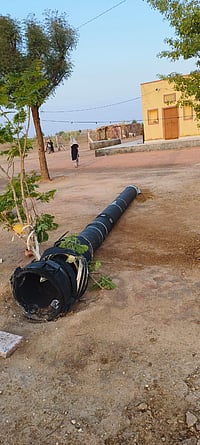The Bharatiya Janata Party’s Diya Kumari on Wednesday claimed that a palace of the erstwhile Jaipur royal family once stood on the land where the Taj Mahal was built and that Mughal emperor Shah Jahan had “occupied” it.
However, historians disagreed with the statement and called it “half-truth”. Kumari is the Lok Sabha MP from Rajasthan’s Rajsamand constituency and a member of the erstwhile royal family of Jaipur.
Documents prove the land for Taj Mahal was bought
Historian Rana Safvi shared copies of farmans (royal orders) from Shah Jahan to Raja Jai Singh on Twitter and wrote that four havelis were given to Jai Singh in exchange of the land for Taj Mahal.
She wrote, "While Raja Jai Singh was willing to donate the land for free, four havelis were given in lieu of Raja Man Singh's haveli by Shah Jahan. This farman is locked up in the Kapad Dwara collection in the City Palace Museum."
Safvi shared copies of farmans from the book Taj Mahal – The Illumined Tomb, edited by by WE Begley and ZA Desai.
She told Outlook, “The Mughals were great record-keepers and the Padshahnama gives details of the construction of the Taj Mahal called Rauza-e-Munawwar. There are farmans to Raja Jai Singh regarding not only compensation of four havelis in lieu of the haveli where the tomb [the Taj Mahal] was built but also relating to the supply of Makrana marble. The farmans are in the Kapad Dwara collection of Jaipur City Palace."
Historian Ira Mukhoty, author of the book Akbar: The Great Mughal, echoed Safvi and pointed out that Mughals and Jaipur royals were close since Akbar married Harkha Bai of Amber.
Ira told Outlook, “It is disappointing to hear these claims by BJP MP Diya Kumari. There is no question of land having been ‘snatched’ by Shah Jahan in this vicious manner.”
Ira added that such claims about the Taj Mahal originate from a single source – a book by PN Oak.
Ira said, “All of these claims arise from a single source, a book by PN Oak, a fantasist, who claimed that many great Asian monuments, including the Kaaba in Mecca, were all results of ‘Hindu architecture’.”
Ira highlighted that Arjumand Bano Begum was given the name Mumtaz Mahal, which meant the exalted one of the palace. Such titles were given to all imperial women. This is why the Taj, which was initially called Roza-e-Munavvara – a unique building – was then changed to Taj Mahal by Shah Jahan in honour of his wife.
Diya Kumari's Taj Mahal claim
Kumari told media on Wednesday that the plot where the Taj Mahal was built historically belonged to the Jaipur royal family and the family has documents to back the same.
She said, "Mughal emperor Shah Jahan ‘occupied it’ as it was their [Mughal] government then. If a government acquires land from you, it gives you compensation but I have heard that in this case there was no compensation given by the Mughals to Jaipur royals. As there was no law where one could appeal than."
Kumari further commented on a petition filed in the Allahabad High Court by UP BJP spokesperson Dr Rajneesh Singh, which seeks orders to the Archaeological Survey of India to open sealed doors of over 20 rooms inside the Taj Mahal premises to check the presence of any Hindu idols or scriptures.
She said, "It is good that he raised the voice. I believe that there should be an inquiry and sealed parts of the Taj Mahal should be opened to find out more. Only a proper enquiry can establish facts. And if it is needed, we will submit the documents in the court."



























